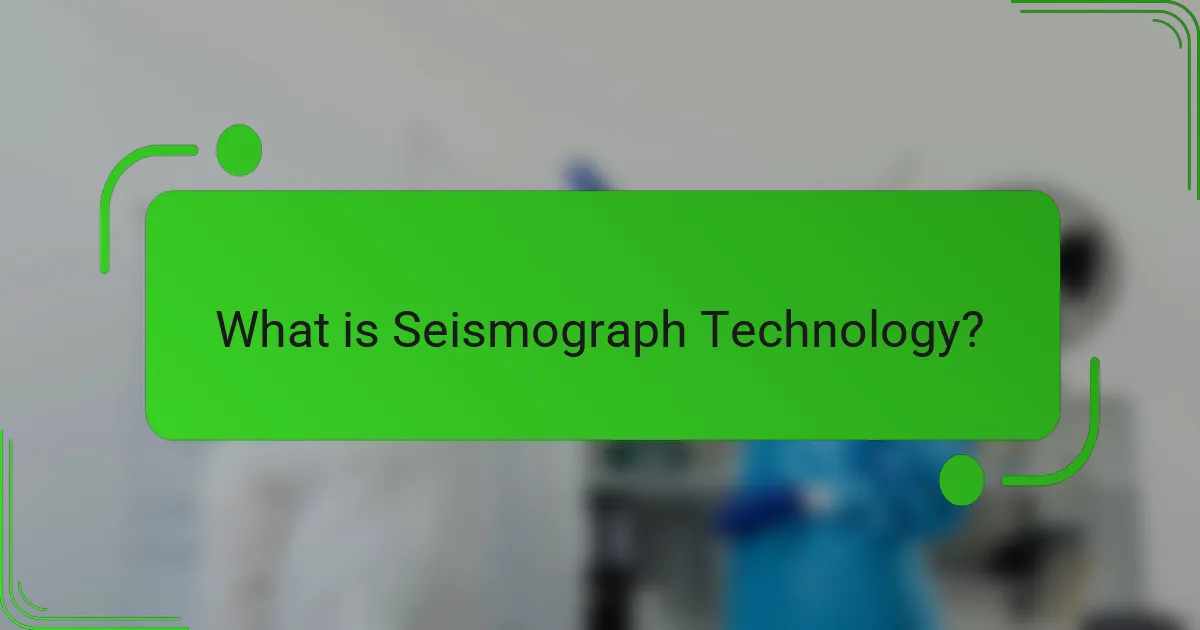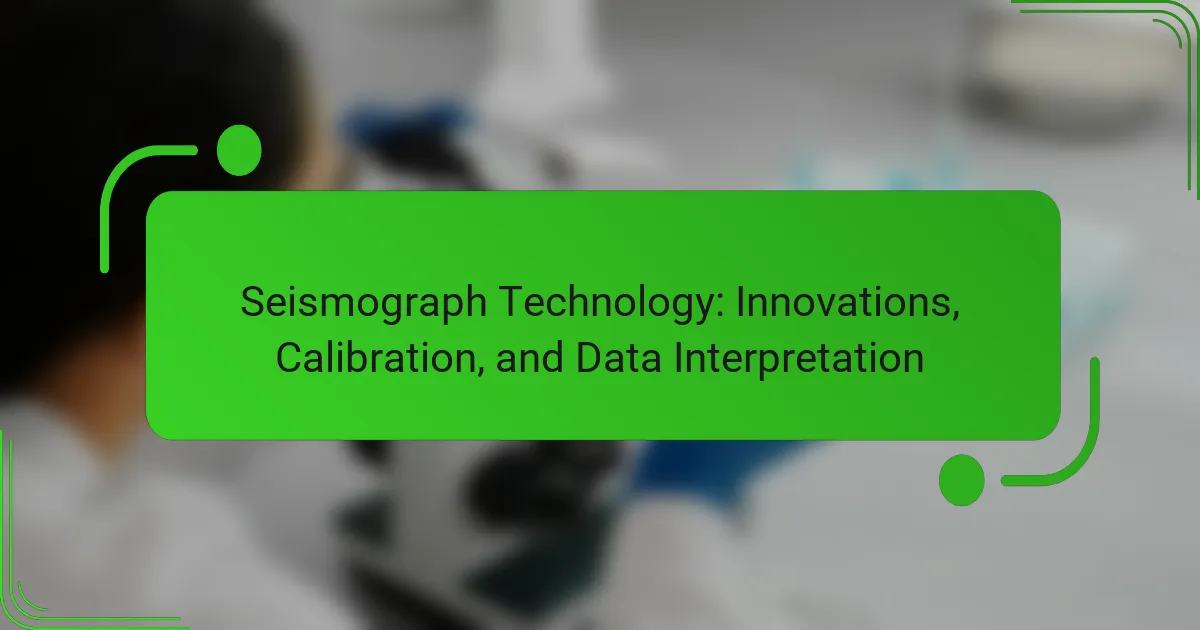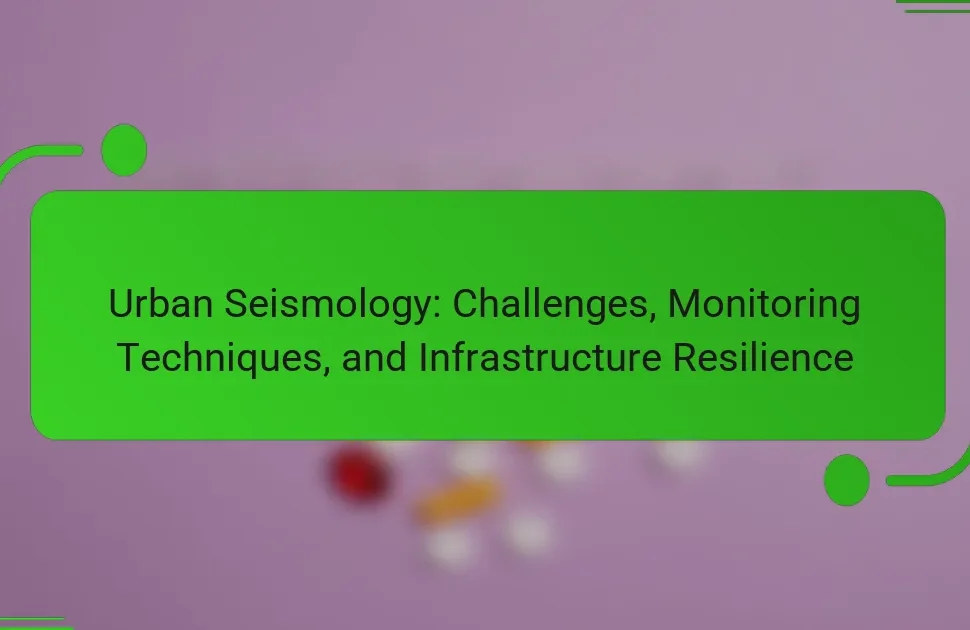Seismograph technology is a scientific instrument designed to measure and record seismic waves generated by earthquakes, explosions, and geological activities. This technology employs a mass suspended on a spring to detect ground movements, with modern devices capable of identifying movements as minimal as a few nanometers. The article explores the evolution of seismographs since their inception in the second century AD, focusing on innovations in calibration and data interpretation. It highlights the critical role seismographs play in earthquake monitoring, enhancing public safety and advancing scientific understanding of seismic events.

What is Seismograph Technology?
Seismograph technology is a scientific tool used to measure and record seismic waves. It detects ground movements caused by earthquakes, explosions, and other geological activities. Seismographs consist of a mass suspended on a spring, which remains stationary while the ground moves. When seismic waves pass, the mass’s relative motion is recorded on a rotating drum or digital device. This technology provides crucial data for understanding earthquake dynamics. Seismographs have evolved significantly since their invention in the second century AD. Modern seismographs can detect movements as small as a few nanometers. They play a vital role in earthquake monitoring and research, contributing to public safety and scientific knowledge.
How does Seismograph Technology function?
Seismograph technology functions by detecting and recording ground motion caused by seismic waves. The device consists of a mass suspended on a spring, which remains stationary while the ground moves. When an earthquake occurs, seismic waves travel through the Earth, causing the ground to shake. This movement is transferred to the seismograph, causing the mass to move relative to the ground. The movement of the mass is recorded on a rotating drum or digital sensor, creating a seismogram. The seismogram displays the amplitude and frequency of the seismic waves. Seismographs can be calibrated to detect different magnitudes of earthquakes. This technology is essential for monitoring seismic activity and understanding geological processes.
What are the key components of a seismograph?
A seismograph consists of several key components. The primary component is the mass or pendulum that moves in response to ground motion. This mass is suspended from a fixed point and is typically attached to a spring. The second component is a recording device, which captures the movement of the mass. This device can be mechanical or digital, depending on the technology used.
Another important component is the frame, which holds the mass and recording device in place. The frame must be sturdy to minimize external vibrations. Additionally, a power source is required for digital seismographs, providing energy to the recording device.
Lastly, there is a calibration mechanism to ensure accurate readings. This mechanism adjusts the sensitivity of the instrument based on the expected seismic activity. Together, these components allow a seismograph to accurately record and analyze seismic waves.
How do these components interact to measure seismic activity?
Seismic activity is measured through the interaction of various components in a seismograph. The primary components include a mass, a spring, and a recording device. When seismic waves travel through the Earth, they cause the ground to shake. This shaking moves the seismograph’s base, while the mass remains stationary due to inertia.
The spring connects the mass to the base, allowing relative motion between the two. As the base moves, the mass’s position changes, which is captured by the recording device. The recording device translates this motion into a visual representation, often on a graph.
This graph displays the amplitude and frequency of the seismic waves, providing crucial data for analyzing the earthquake’s strength and duration. The calibration of these components ensures accurate measurements, making it possible to interpret seismic activity effectively.
What innovations have emerged in Seismograph Technology?
Recent innovations in seismograph technology include the development of digital seismometers. These devices offer higher sensitivity and improved data accuracy compared to traditional analog models. Enhanced GPS technology has also been integrated. This allows for precise location tracking of seismic events. Moreover, real-time data transmission capabilities have been implemented. This advancement enables immediate analysis and response to seismic activity. Machine learning algorithms are increasingly used for data interpretation. They help in identifying patterns and predicting seismic events. Additionally, the use of fiber optic sensors is on the rise. These sensors provide a broader range of data collection and are less prone to environmental interference.
How have advancements in sensors improved accuracy?
Advancements in sensors have significantly improved accuracy in seismograph technology. Enhanced sensor sensitivity allows for the detection of smaller seismic events. Modern sensors utilize advanced materials that reduce noise and increase signal clarity. Digital signal processing algorithms further refine data interpretation. These technologies enable more precise measurements of ground motion. For instance, improvements in accelerometers have increased measurement range and resolution. Research indicates that these advancements have reduced the margin of error in seismic readings by up to 30%. Consequently, the accuracy of earthquake detection and analysis has greatly benefited from these innovations.
What role does software play in modern seismograph systems?
Software plays a crucial role in modern seismograph systems by enabling data acquisition, processing, and analysis. It facilitates real-time monitoring of seismic activities. Software algorithms filter noise and enhance signal clarity. This improves the accuracy of earthquake detection and location. Advanced software systems can integrate data from multiple sensors. They provide comprehensive analysis and visualizations of seismic events. Additionally, software assists in automating calibration processes. This ensures the reliability and precision of seismographic measurements. Overall, software enhances the functionality and effectiveness of modern seismograph systems.
Why is calibration crucial in Seismograph Technology?
Calibration is crucial in seismograph technology to ensure accuracy in measuring seismic activity. Accurate calibration allows seismographs to detect and record vibrations correctly. This precision is vital for interpreting data related to earthquakes and other geological events. Without proper calibration, seismographs may produce misleading results. Misleading data can lead to incorrect assessments of seismic hazards. Regular calibration is necessary to maintain the reliability of seismographic measurements. Research indicates that calibrated instruments provide a more accurate representation of ground motion. Thus, calibration directly impacts the effectiveness of earthquake monitoring and response strategies.
What methods are used for calibrating seismographs?
Calibration of seismographs is typically achieved through several methods. One common method is the use of known seismic sources. These sources generate waves of a specific frequency and amplitude. The seismograph is then adjusted to ensure accurate readings of these waves. Another method involves using mechanical calibration techniques. This includes applying known forces to the seismograph to verify its response. Additionally, electronic calibration is performed using signal generators. These generators provide precise signals to test the seismograph’s accuracy. Calibration can also involve field testing with controlled explosions or vibrations. This ensures the seismograph performs well under real-world conditions. Regular maintenance and recalibration are essential for reliable data collection.
How does calibration impact data reliability?
Calibration directly impacts data reliability by ensuring that measurement instruments provide accurate and consistent results. Proper calibration aligns the instrument’s output with known standards. This process reduces systematic errors that could distort data interpretation. For example, a seismograph that is not calibrated may misinterpret seismic waves, leading to incorrect readings. Research indicates that regularly calibrated instruments can improve data accuracy by up to 30%. Consistent calibration also enhances the comparability of data across different studies. Therefore, calibration is essential for maintaining high data reliability in seismograph technology.
How is data interpreted in Seismograph Technology?
Data in seismograph technology is interpreted through the analysis of seismic waves. Seismographs record ground motion caused by earthquakes or other seismic events. The recorded data appears as waveforms on a seismogram. Analysts examine these waveforms to identify different types of seismic waves, such as P-waves and S-waves. Each wave type has distinct characteristics, including speed and amplitude. The arrival times of these waves help determine the earthquake’s epicenter. Additionally, the amplitude of the waves indicates the earthquake’s magnitude. Advanced algorithms and software assist in processing and visualizing this data for accurate interpretation.
What types of seismic data are collected?
Seismic data collected includes ground motion data, seismic waveforms, and event location data. Ground motion data measures the displacement, velocity, and acceleration of the ground during seismic events. Seismic waveforms capture the propagation of seismic waves through different geological layers. Event location data identifies the coordinates and depth of the seismic source. These types of data are essential for understanding earthquake dynamics and assessing seismic hazards. Seismographs and accelerometers are commonly used instruments for collecting this data.
How do scientists analyze seismic waves for insights?
Scientists analyze seismic waves using various methods to gain insights into Earth’s structure and seismic activity. They deploy seismographs to record the waves generated by earthquakes or artificial sources. The data collected includes wave amplitude, frequency, and arrival times.
Scientists categorize seismic waves into primary (P) and secondary (S) waves. P waves travel faster and indicate the initial energy release. S waves follow and provide information about material properties. By analyzing wave patterns, scientists can identify the location and magnitude of seismic events.
Additionally, they utilize techniques like tomography to create 3D images of subsurface structures. This involves analyzing how seismic waves change speed and direction as they pass through different materials. The insights gained can inform hazard assessments and improve building designs in earthquake-prone areas.
What challenges do researchers face with Seismograph Technology?
Researchers face several challenges with seismograph technology. One major issue is the calibration of instruments. Accurate calibration is essential for reliable data collection. Miscalibrated devices can lead to erroneous readings. Environmental factors also pose significant challenges. Variations in temperature and humidity can affect sensor performance. Noise interference from human activity complicates data interpretation. Researchers must filter out this background noise for clarity. Additionally, the cost of advanced seismograph technology can be prohibitive. Limited funding can restrict access to the latest equipment. Lastly, data management is a challenge. The vast amount of data generated requires efficient storage and analysis methods.
How do environmental factors affect data collection?
Environmental factors significantly impact data collection in seismograph technology. Conditions such as temperature, humidity, and atmospheric pressure can affect sensor accuracy. For instance, extreme temperatures may lead to sensor drift, causing erroneous readings. Additionally, high humidity can introduce noise into the data, complicating signal interpretation. External vibrations from wind or nearby machinery can also interfere with the seismic signals being measured. Research indicates that calibration must account for these environmental variables to ensure reliable data. Studies have shown that uncalibrated instruments in varying conditions yield inconsistent results, highlighting the need for adaptive calibration methods.
What are common issues in data interpretation?
Common issues in data interpretation include misinterpretation of noise and signal. Noise can obscure real data, leading to incorrect conclusions. Additionally, bias in data selection can skew results. Incomplete datasets can result in misleading interpretations. Overlooking contextual factors often leads to errors in analysis. Misunderstanding statistical significance can also distort findings. In seismograph data, differentiating between actual seismic events and background vibrations is crucial. These issues can compromise the accuracy of seismic assessments.
What are best practices for using Seismograph Technology?
Best practices for using seismograph technology include regular calibration and maintenance of the instruments. Calibration ensures accurate readings by aligning the seismograph with known standards. Maintenance involves checking for wear and tear, and replacing any faulty components. Proper installation is crucial; seismographs should be placed on stable ground away from vibrations. Data collection protocols should be established to ensure consistent and reliable data. Operators should be trained in interpreting seismographic data to avoid misinterpretation. Finally, data should be stored securely and backed up to prevent loss. These practices enhance the reliability and accuracy of seismic monitoring.
Seismograph technology is a scientific tool that measures and records seismic waves, providing critical data for earthquake monitoring and geological research. This article covers the fundamental components of seismographs, their operational mechanics, and recent innovations such as digital sensors and machine learning applications. It also highlights the importance of calibration for data accuracy, methods for interpreting seismic data, and the challenges faced in the field. Best practices for the effective use of seismograph technology are discussed to enhance reliability and data integrity.




